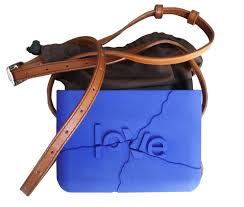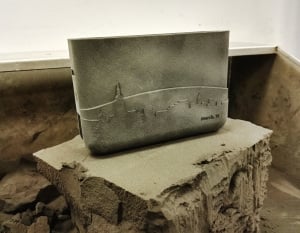
This article originates from Women In 3D Printing and is part of our effort to support the use of 3D printing technology by women. The article is re-published with permission.
Annallisa Nicola is the CEO and co-founder of XYZBAG. She is sharing here her vision and experience of the 3D printing industry as a female entrepreneur using the 3D printing technology as a manufacturing tool.
Nora Toure: Annalisa, could you let us know about your background and what brought you into 3D printing in the first place?
Annalisa Nicola: I came from Turin, capital of the Piedmont region (north of Italy), well known as the home of the headquarter of automobile manufacturer FCA and important industrial districts. This complex cultural heritage has really influenced my vocational education, becoming over time a creative instrument to orient an independent research on technology culture and future. Ever since I was a child, thanks to my father’s involvement in the plastics industry, I have had the chance to keep contact with technology innovation, material and manufacturing process. I always try to reinterpret this imprinting in a contemporary way, by keeping design attitude as a key leitmotif to intensify.
I have a technical degree in industrial design, a well as a master degree in Eco Design at Polytechnic of Turin. At the time I was getting this master in Paris at ENSCI, (École nationale supérieure de création industrielle), where I spent my thesis research project exploring what the future of sharing services could be by connecting people of the same block through an inter-phone. It was the first time I got in touch with the power of “internet of things”. I realized my inter-phone prototype in wood, and still now I imagine how amazing it could have been if I had had a 3D printing desk at the laboratory to develop my design.
Thanks to my work experience in a variety of professional design environments and my wide-ranging personal interests, I acquired technical skills in various fields for industrial product development, playing a mediating role between creative departments and technicians involved in the creation of new products. I am still advisor for Maip, a leader company in the Italian panorama of technical polymers, as consultant for design and communication. I’m also a founding member of a local Fab Lab organization and CEO of XYZBAG. Fashion and the insane love for bags has constantly accompanied my path, becoming in time a latent project looking for a better enforcement and the right partner to start with. 3D is the arrival point of a long and complex process started many years before.

Maintaining high the attachment to plastics and product design, I began to design bags with a strong engineering character. I loved to sketch bags everywhere. Wherever there were a pencil and a piece of paper. After studying in Paris I started to draw with the idea to create a collection of bags produced through the injection molding technology. Simultaneously I explored the traditional handcraft for accessories and deepened in Milan the traditional techniques of production for cutting and sewing of leather and related materials. I also created some shopping leather bag models that I usually wear, with the support of seamstress. However in all these years I have never abandoned the constant research for tailored uniqueness through an “industrial” model. Unfortunately with existing industrial transformation processes this diversification was unthinkable. Therefore discarded the possibility of differentiating the design with a traditional molding I approached the 3D printing. The additive technology was already established in the business industry for the development of pre-series. Unknown and original was the idea to look at these technologies in a manufacturing perspective. By considering a prototype a product itself we have reclaimed the industrial world and reconsidered the potential of prototyping in a tailoring perspective.
Nora Toure: Do you remember your first 3D printed model?
Annalisa Nicola: I started out being fascinated with 3D printing thanks to an illuminating book Makers: The New Industrial Revolution by Chris Anderson. I usually say it helped me to think possible something didn’t exist yet. Passionate of Iris Van Herpen visionary explorations and Anouk Wipprecht Arduino experimentation in textiles, I discovered the Makers world. I really enjoyed the Fab Lab culture, open-source digital shops where modern enthusiastic experts provide tools and expertise to help you realize your ideas.
In that context I made my first trials, with a latest generation of Sharebot 3D printer . My first bag model was made in FDM. I was totally fascinated by the filament, the amazing mystery of transforming digital dimension physically, in a reasonable time. The special layer additive effect introduces an interesting new aesthetic. Looking at that filament I understood that something extraordinary was happening.
Nora Toure: Let’s talk a little bit more of your company, XYZBAG. Could you explain furthermore the products and services that you are offering?

Annalisa Nicola: At XYZBAG we follow uniqueness as a sign of authenticity. XYZBAG is a young startup founded in in the latter part of 2015 that would like to exploit the most advanced industrial technological tools to produce co-created fashion sartorial handbags. We especially create tailored cyber bags, right to you and for you, empowered by 3D printing technologies. The bag is much more than an object of desire. It is an evolving project. A talking item that preserves the essential memory of the co-creation experience.
Today, the slow manufacturing processes of prototyping allow us to imagine products where technology and uniqueness will be the new codes of authenticity. The result of advances in 3D printing production is going to reset the lines between prototype and product, by revisiting the tradition of hand-made craft as digital craft where hand-made is replaced by a code. The bags are custom designed as per the individual’s personality, mood, or the occasion. Each bag is produced one at a time. Twelve hours of production, layer by layer. A few hours of rest not to stress the piece inside the powder block and finally a hand made post-treatment finishing.
During the industrial New Product Design process, every design research needs to find the right shape before going to market. At XYZBAG, design is a dynamic value. Every customization is a beta version that becomes the ended product at the meantime. Thanks to XYZBag you could buy a new generation of 3D bags through an e-commerce online. Innovative open source technologies for 3D graphics in the browser create a futuristic purchasing exposure. The client/user actively enters the creation by choosing among different levels of customization.
Nora Toure: Do your customers mostly customize their own bag or do they buy from your online gallery?

Annalisa Nicola: Some of them take inspiration from the web, others prefer to exploit the maximum possibilities offered by this amazing technology, by asking us to develop their own inspiration. This is the most exciting part of my work. To enter in contact with their desires and looking for the best solution to make them possible.
We know a new generation is emerging that is looking for things more meaningful and especially their own uniqueness. I’m talking about millennials and especially Generation Z that are building their own individual identities which have nothing to do with definitions or norms. A generation for which time, authenticity and individuality are the new codes of consumption. If they can inject their personality and perspective into a product, then it’s going to be at the very least unique. By following the make to order strategy we allow our customers to purchase bags that are personalized according to their specifications.
We give 4 types of customization that correspond to different grades of co-creation. Thanks to a collaboration with our designers and suppliers we transform their inspiration into a digital file ready for printing. We manufacture the end product once we receive the order. Each bag is born with a special identification code.
If you can surprise yourself by giving something about you to a product you’ll love it more.
Nora Toure: How did you came to build the company?

Annalisa Nicola: I started drawing bags when I was teenager, only for passion. It was inevitable. Searching for new geometries, structures and materials to better express my interpretation of bags, over time it has matured the idea to transform this passion into a business idea.
The project evolution moves together with the research of the right partner to make it happen. I met Matteo in a rainy afternoon. From different backgrounds, we rediscovered both excited by the new 3D technology and the digital world. Always interested in angel investing for reasons that go beyond pure monetary return, Matteo as mentor and executive entrepreneurs decided to make use of his experience by helping me to develop a business model. Together we founded XYZBAG.
Nora Toure: Do you have any (fun or not) story about the company to share with us?
Annalisa Nicola: I am a pretty social type who really likes a good energy flow with people. As a startup, validations of our hypothesis have always been very important to find the right way. They still are. At the beginning the first trials were made in FDM and the functional design was not defined yet. Different suppliers concurred to delineate each component of the bag without having the overview of the whole one and above all without knowing it was a bag.
Something strange happened with the real prototypes I made at the Fab Lab. In order to understand some technical crucial points of the design we decided to do some tests by printing some smaller scaled bags, to avoid the overloading of the 3D print desk (too much time to realize a 1:1 size one in FDM). When I moved to the Fab Lab to look at the prototypes I found them on a desk. They were all on line, full of pens, scissors, cables and everything you can find in an office. Nothing to do with fashion but lots of with function. People used them as boxes. And they loved them! I really enjoyed seeing this usage extension in a different context. It brought me to the evidence of the industrial character of our fashion accessory.
Nora Toure: As a woman entrepreneur, what was/ is your biggest challenge? Any challenge specific to the 3D printing industry?
Annalisa Nicola: As a woman entrepreneur, my biggest challenge is being able to share my vision, transfer my enthusiasm to the others and communicate my ideas in a simple and accessible way, by making it profitable at the same time. Our works are technology-driven. 3D printing is an amazing tool that keeps us connected to this world in a sartorial way. However 3D printing has to be disruptive, exploring more and more technical solutions for manufacturing. Filling the gap between the pre-series and the final product by a prototype itself, new requirements need to be solved. The end customer market is much more demanding, especially for aesthetic and touch feelings.
Nora Toure: What makes the 3D printing industry particularly interesting for you as a business person?
Annalisa Nicola: Every entrepreneur knows that productivity is one of the key ingredients for successful product development. 3D printing makes me discover a new perception of time into the industrial domain. An industrial process that follows sartorial logic. Low quantities, maximum customization for high specialized products.

Fashion industry requires fast innovation in short time. The dynamic changeable design offered by this technology offers the opportunity to rethink the concept of collection. There is a near future where products will be made possible only by you, because they will be co-created with the help of the brand that develops it. An idea takes shapes in a reasonable and fascinating time lapse. The efficiency of productivity is replaced by the speed of product changing to the market. For instance, the ability to easily modify designs lends to automated customization of products.
Machine and material communicate each other through a design file where automation, ruled by human expertise, knows a new sartorialisme. 3D printing is one of the first areas where digital truly meets physical.
Nora Toure: As a woman?
Annalisa Nicola: As a woman I consider 3d printing a fantastic way to empower imagination. It represents the right balance between the creative sensibility and the rational discipline that technology requires. Creativity is not enemy to rationality.
By inspiring people to express their own personality through technology you understand their desires and fashion needs from different perspectives. It deals with an exciting experience where emotional inputs could be transformed into data to create physical object that talk about you and become real products.
Nora Toure: What do you think of the 3D printing industry today? And how would you like to see it evolve?
Annalisa Nicola: 3D printing is a great opportunity to explore and innovate. For the last decade, 3D printing has been the playground of the maker community, while commercial applications have been limited to prototyping. But now, industrial 3D printing is about to go mainstream in a way that will revolutionize the economy. Especially from a manufacturing point of view. Conceiving it in a disruptive way, by placing the current technologies out of the box, you could identify new areas of application. Fashion is one of this.

Anyway even if 3D printing is knowing more and more success thanks to end-user marketplace that allow you to easily purchase a product after uploading a file, today there are a few businesses that use 3D printing for creating final products. These companies are early adopters who capably use today’s limited 3D printing offerings. I think the real goal is to empower expertise on it in order to generate new niche markets for specific applications. Visionary design companies where business suppliers could be involved into. Prototyping for manufacturing needs a very strong know-how and expertise. A team of 3D designers, transformation and material engineers, web and digital experts and IP consultants, will concur to redefine this new industrial system.
The file is the substantial key of this transformation. And the automation for transmitting this info thorough digital will be substantial. As the industrial revolution was defined by radical efficiency in production, the digital revolution is defined by radical efficiency in information transmission. Implementing growth opportunities through the hybridation of different technologies or the integration with innovative technological devices as well.
Nora Toure: In your opinion, how could we encourage more women to become involved with 3D Printing?
Annalisa Nicola: We are in an historical moment in where it grows the struggle between desire to homologate and the will to stand out from others. In this trend design assumes a key role to mark the value of uniqueness. Make these women became more familiar with this culture could help exploring new technologies.
And don’t forget to join the Women in 3D Printing group on LinkedIn and Facebook

